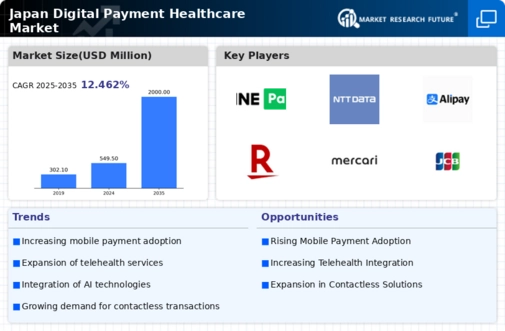Government Initiatives and Support
The Japanese government is actively promoting the digital payment-healthcare market through various initiatives aimed at enhancing healthcare accessibility and efficiency. Policies encouraging the adoption of electronic payment systems in healthcare settings are being implemented. For instance, the government has set a target for 80% of healthcare payments to be processed digitally by 2027. This initiative is part of a broader strategy to modernize the healthcare system and improve patient outcomes. Additionally, financial incentives for healthcare providers who adopt digital payment solutions are likely to stimulate market growth. As these government efforts continue, the digital payment-healthcare market is expected to flourish, fostering a more integrated healthcare ecosystem.
Rising Consumer Demand for Convenience
Consumer preferences in Japan are shifting towards convenience and efficiency, significantly impacting the digital payment-healthcare market. Patients increasingly favor digital payment options that allow for quick and easy transactions, reducing wait times and enhancing overall satisfaction. Surveys indicate that approximately 65% of patients prefer using digital payment methods over traditional cash payments. This trend is further fueled by the growing use of smartphones and mobile applications, which facilitate seamless payment experiences. As healthcare providers respond to this demand by integrating user-friendly payment solutions, the digital payment-healthcare market is poised for substantial growth, aligning with consumer expectations for modern healthcare services.
Increased Focus on Health Data Management
The digital payment-healthcare market is also influenced by the growing emphasis on health data management and interoperability. As healthcare providers in Japan seek to streamline operations and improve patient care, the integration of payment systems with electronic health records (EHR) is becoming more common. This integration allows for real-time processing of payments while ensuring that patient data remains secure and accessible. In 2025, it is projected that around 50% of healthcare facilities will have adopted integrated payment and health data management systems. This trend not only enhances operational efficiency but also fosters trust among patients, thereby driving the growth of the digital payment-healthcare market.
Emergence of Fintech Solutions in Healthcare
The rise of fintech companies in Japan is reshaping the digital payment-healthcare market by introducing innovative financial solutions tailored for healthcare providers. These companies are developing specialized payment platforms that cater to the unique needs of the healthcare sector, such as billing automation and patient financing options. As of 2025, it is estimated that fintech solutions could account for up to 30% of all digital payment transactions in healthcare. This shift is likely to enhance the financial management capabilities of healthcare institutions, allowing them to focus more on patient care rather than administrative tasks. Consequently, the digital payment-healthcare market is expected to benefit from this influx of fintech innovations, driving further adoption of digital payment methods.
Technological Advancements in Payment Systems
The digital payment-healthcare market in Japan is experiencing a surge due to rapid technological advancements. Innovations such as contactless payments and mobile wallets are becoming increasingly prevalent. In 2025, it is estimated that over 70% of healthcare transactions will utilize digital payment methods, reflecting a significant shift from traditional cash-based systems. This transition is driven by the need for efficiency and convenience in healthcare transactions. Furthermore, the integration of artificial intelligence and machine learning in payment processing is enhancing fraud detection and improving user experience. As healthcare providers adopt these technologies, the digital payment-healthcare market is likely to expand, offering patients seamless payment options and reducing administrative burdens for healthcare institutions.



















Leave a Comment